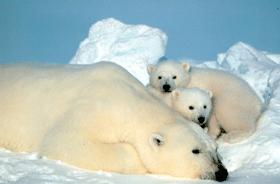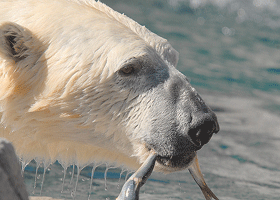Threatened Bear May Hold Health Secrets
Air Date: Week of May 16, 2008

(Photo: Lee Foster)
The Bush administration has acknowledged that polar bear habitat is diminishing because of climate change and has declared the bear a threatened species. Host Bruce Gellerman talks with Dr. Aaron Bernstein, co-editor of the new book “Sustaining Life: How Human Health Depends on Biodiversity,” who says studying polar bears in their natural environment could help us understand diseases like diabetes and osteoporosis.
Transcript
[RETURN THEME]
GELLERMAN: From the Jennifer and Ted Stanley Studios in Somerville, Massachusetts – this is Living on Earth. I’m Bruce Gellerman, in for Steve Curwood.
The polar bear is officially on thin ice. After fighting lawsuits by conservation groups for years, the U.S. Interior Department has reluctantly agreed to add the polar bear to the government’s list of threatened animals under the Endangered Species Act. The bears are threatened by the loss of an important part of their habitat: sea ice. Global warming is melting the ice far faster than expected, said Interior Secretary Dirk Kempthorne as he announced his long awaited decision.
KEMPTHORNE: When we’ve looked at what is actually happening in the arctic, we have found considerably less sea ice than the models are even projecting. This, in my judgment, makes the polar bear a threatened species, one likely to become in danger of extinction in the foreseeable future.
GELLERMAN: But even as Kempthorne identified global warming as a threat, the Secretary made it clear that the polar bear listing – under the Endangered Species Act – would do nothing to limit global warming gases.

(Photo: Steve Amstrup/U.S. Fish and Wildlife Service)
GELLERMAN: In an unusual move, Kempthorne specifically exempted the threat to polar bears from being linked to greenhouse gases. The move allows oil and gas companies to explore and drill in polar bear habitat. Environmentalists say Kempthorne’s interpretation of the law turns his decision into little more than a symbolic act. Susan Casey Lefkowitz is an attorney with the Natural Resources Defense Council. It’s one of the groups that sued to force the Bush administration to act on behalf of polar bears.
CASEY LEFKOWITZ: This decision seems to be so full of loopholes that we’re actually wondering how much it’s actually going to protect the polar bear. Instead they seemed to talk about business as usual, especially with the oil and gas industry, and that just does not seem compatible with the protection of the polar bear.
GELLERMAN: Environmentalists aren’t the only critics of Kempthorne’s decision. Property-rights advocates and oil interests aren’t happy either, and say they’ll file lawsuits to overturn the Interior Department’s ruling. But the polar bear is not just an icon of the environmental movement. It could play a critical role in human medical research.
Aaron Bernstein of Harvard Medical School is co-editor of the soon to be published book “Sustaining Life: How Human Health Depends on Biodiversity.”
BERNSTEIN: The polar bear is a metabolic marvel. It’s able to do things that we could only dream of. And one of the things that’s particularly valuable to humans is that when the female bear’s in the winter den, they put on tremendous amounts of blubber, and yet they don’t develop diabetes. And we need to sort out how they do that, because we have an epidemic of Type II diabetes related to obesity in our country. And when humans become obese they become at increased risk of developing type two diabetes. Polar bears, however, somehow seem to escape that fate, but we really don’t understand how.

The Bush administration delivered its long-awaited decision on how to protect the polar bear by listing it as "threatened" under the Endangered Species Act. (Photo: Lee Foster)
BERNSTEIN: In a sense yes, except that we have to study them in the wild, because the only way they’re able to put on that amount of weight is by eating seal blubber, in fact gorging on it – they can eat a hundred pounds of it at a time – so having them in a lab actually won’t help us learn how they do it.
GELLERMAN: Why polar bears? I mean, a polar bear’s not like a human.
BERNSTEIN: Well it turns out that we’re a lot more related to a lot of things than some of us would like to believe. You know, the Earth is an extraordinary place with extraordinarily diverse life. That life has adapted to all of these extraordinary places that creatures live, and it is those adaptations that are incredibly valuable to us as humans because they can help us solve some of the most difficult medical problems we face.
GELLERMAN: I was reading that polar bears might help us solve osteoporosis.
BERNSTEIN: Denning bears, like polar bears, females in particular, spend the winter months not being very active while they’re denning, and during this time they don’t lose any bone. If a human spent months without moving, they would lose a quarter or a third of their bone, leading to a condition known as osteoporosis. Somehow denning bears seem to avoid that fate. Osteoporosis is also a major public health problem in the country. These creatures have potentially invaluable information to helping us better treat some of the most widespread diseases in our population, in the United States, but worldwide, and to lose them would be an act of perhaps unparalleled folly.

Scientist Aaron Bernstein says like people polar bears gain a lot of weight when they den, but - unlike people - don’t get diabetes. (Photo: Kristi Harper)
BERNSTEIN: There are a total of five species of bear that are currently listed as threatened with endangered. We really, frankly, don’t know what secrets these species may hold. But the reality is that the closer we look at the natural world and the adaptations that are present there, the more we learn about ourselves and how we might understand how our bodies work and how we might better treat them when there’s illness.
GELLERMAN: Well, Dr. Bernstein, I want to thank you very much.
BERNSTEIN: Thanks so much for having me.
GELLERMAN: Aaron Bernstein is co-editor of the book “Sustaining Life: How Human Health Depends on Biodiversity.”
Links
Living on Earth wants to hear from you!
Living on Earth
62 Calef Highway, Suite 212
Lee, NH 03861
Telephone: 617-287-4121
E-mail: comments@loe.org
Newsletter [Click here]
Donate to Living on Earth!
Living on Earth is an independent media program and relies entirely on contributions from listeners and institutions supporting public service. Please donate now to preserve an independent environmental voice.
NewsletterLiving on Earth offers a weekly delivery of the show's rundown to your mailbox. Sign up for our newsletter today!
 Sailors For The Sea: Be the change you want to sea.
Sailors For The Sea: Be the change you want to sea.
 The Grantham Foundation for the Protection of the Environment: Committed to protecting and improving the health of the global environment.
The Grantham Foundation for the Protection of the Environment: Committed to protecting and improving the health of the global environment.
 Contribute to Living on Earth and receive, as our gift to you, an archival print of one of Mark Seth Lender's extraordinary wildlife photographs. Follow the link to see Mark's current collection of photographs.
Contribute to Living on Earth and receive, as our gift to you, an archival print of one of Mark Seth Lender's extraordinary wildlife photographs. Follow the link to see Mark's current collection of photographs.
 Buy a signed copy of Mark Seth Lender's book Smeagull the Seagull & support Living on Earth
Buy a signed copy of Mark Seth Lender's book Smeagull the Seagull & support Living on Earth

